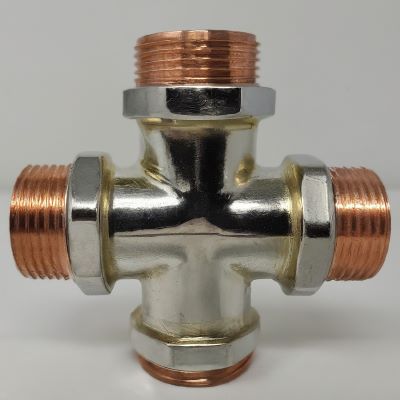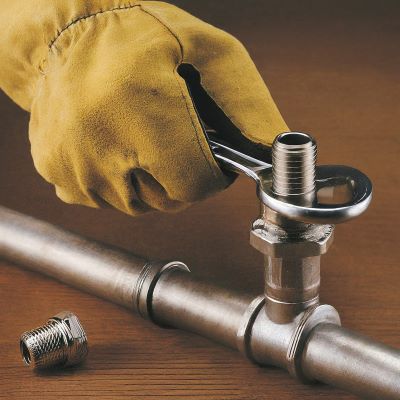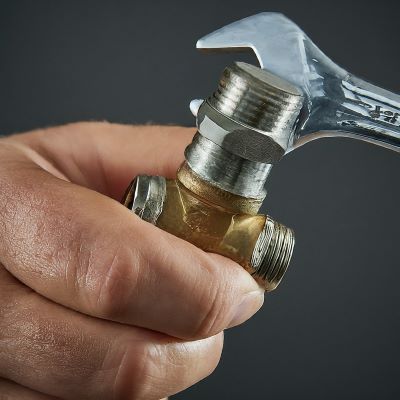Have you ever been in the middle of a DIY project when a pesky leak derailed everything? Leaky connections, whether from a burst irrigation line or a malfunctioning brake line, can turn a simple project into a stressful mess.
But fear not, DIY warriors! Steel line compression fittings are here to save the day, offering leakproof connections that are easy to install and built to last.
What are Steel Line Compression Fittings?
Unlike traditional methods that involve messy threading or soldering, steel line compression fittings provide a clean, secure, and leak proof connection. Imagine a three-piece puzzle: the body acts as the base, the nut screws down like a lid, and the ferrule, a soft metal ring inside, hugs the pipe like a welcoming embrace. Tightening the nut compresses the ferrule around the pipe, creating a watertight seal that holds strong even under pressure.
Advantages of Using Steel Line Compression Fittings
Here are the list of advantages why you should opt for steel line compression fittings:
➡️ Leakproof Connections: Say goodbye to dripping faucets and gushing hoses. Compression fittings create an impenetrable seal, ensuring a smooth and worry-free flow in your plumbing system.
➡️ Ease of Installation: Ditch the torches and messy thread sealants. Installing compression fittings is as easy as 1-2-3! Simply cut the pipe, slip on the fitting, and tighten the nut. No welding or complicated techniques required.
➡️ Versatility: From tiny bathroom faucets to big plumbing pipes, compression fittings can handle it all. Their compatibility with various pipe materials and sizes, including copper, PEX, and steel, makes them the perfect all-in-one solution for leak proof connections.
➡️ Durability: Don’t be fooled by the ease of installation. Steel construction and corrosion-resistant ferrules ensure your connections stay strong and leakproof for years to come, even when exposed to harsh elements.
➡️ Reusability: Made a mistake? No problem! Unlike permanent solutions like soldering, compression fittings allow for easy disassembly and reuse. Simply unscrew the nut, swap out the fitting, and you’re back on track.
Choosing the Right Compression Fitting
Before diving headfirst into a compression fitting frenzy, consider these key factors to ensure a successful project:
➡️ Pipe Material and Size: Make sure the fitting matches the material and diameter of your pipes. Mismatched sizes are a recipe for leaks and frustration.
➡️ Application Pressure: Not all fittings are created equal. Choose a fitting rated for the pressure your project demands, whether it’s a gentle trickle for your faucet or a high-pressure line for your car’s brakes.
➡️ Temperature Requirements: Think hot water lines or icy cold pipelines? Select a fitting that can handle the temperature extremes of your application.
➡️ Space Constraints: Tight quarters? Opt for compact fittings that won’t add unnecessary bulk to your project.
Ferrule Material Matters
While copper ferrules are the go-to choice for most applications, stainless steel offers enhanced corrosion resistance for demanding environments with constant moisture or exposure to chemicals. Consult a professional if you’re unsure which ferrule material best suits your needs.
Installation Tips for Flawless Connections
Now, let’s get down to business! Here’s a step-by-step guide to installing compression fittings like a pro:
-
Prep Your Pipes: Cut your pipes clean and square using a pipe cutter. Deburr any sharp edges with a file to ensure a smooth surface for the ferrule.
-
Apply Thread Sealant (Optional): While not always necessary, thread sealant can provide an extra layer of protection against leaks, especially on threaded connections. Apply a thin layer of thread sealant to the threads before screwing on the fitting.
-
Slide on the Fitting: Make sure the ferrule is facing the correct direction (consult the fitting instructions if needed).
-
Tighten the Nut: Hand-tighten the nut first, then use a wrench to give it a firm but controlled twist. Don’t over-tighten, or you might crush the ferrule and compromise the seal.
-
Test for Leaks: Open the valve and check for any drips or weeping at the connection point. If you see any leaks, double-check your connections and try tightening the nut a little more (within reason). Remember, a snug fit is key, but don’t over-do it.
Troubleshooting Tips: Leaky Woes Be Gone!
Even with the magic of compression fittings, the occasional leak can sneak in. But fear not, leak busters! Here’s how to tackle some common culprits and get your pipes back to their leakproof glory:
1. The Not-So-Tight Nut: Sometimes, overzealous wrench work can lead to a crushed ferrule and a leaky mess.
➡️ Solution: Loosen the nut slightly, replace the ferrule if necessary, and re-tighten with a gentle yet firm grip. Remember, it’s not a powerlifting competition!
2. The Misaligned Ferrule: If the ferrule isn’t snugly hugging the pipe, leaks can form at the edges.
➡️ Solution: Unscrew the nut, reposition the ferrule, and try again. Make sure both pipe and ferrule are clean and free of debris for a perfect seal.
3. The Damaged Threads: Threads on the fitting or pipe can get nicked or corroded, compromising the seal.
➡️ Solution: For minor damage, try applying thread sealant to fill in the gaps. For significant damage, replacing the fitting or pipe might be necessary.
4. The Overlooked Thread Sealant: While not always essential, thread sealant can be your leakproof BFF, especially for applications with higher pressure or potential for movement.
➡️ Solution: Apply a thin layer of sealant to the threads before screwing on the fitting for an extra layer of leak prevention.
5. The Ghost in the Machine: Sometimes, leaks can occur at invisible cracks or pinholes in the pipe itself.
➡️ Solution: This might require replacing the affected section of pipe. If unsure, consult a professional plumber for expert diagnosis and repair.
Conclusion: Banish Leaks and Embrace the Power of Compression!
Steel line compression fittings are more than just plumbing heroes; they’re leakproof saviors for all your DIY projects. Whether you’re tackling a bathroom revamp, plumbing a new kitchen sink, or upgrading your brake lines, these versatile and easy-to-install fittings offer the perfect blend of security, simplicity, and durability.
So ditch the leaky, frustrating past and embrace the power of compression! No more messy thread sealants, no more frantic calls to emergency plumbers, just clean, worry-free connections that stand the test of time.
Post time: Mar-08-2024




